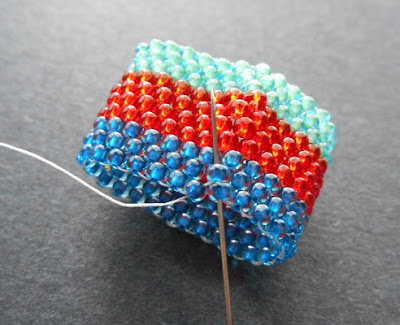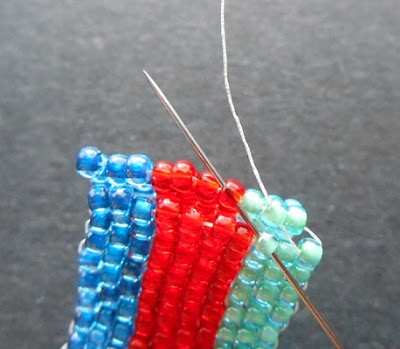
In our first Master Class lesson, we looked at the way that the two-drop, or two-bead variation of peyote stitch is easier to start, and can help you practice the stitch. If you’ve experimented with two-drop peyote and have developed some of that essential muscle memory, it’s time to move on and tackle the terrifying even-count peyote. Once you’ve mastered those first 3 rows, we’ll practice some essentials like weaving in threads and zipping up the edges of a peyote strip to form a tube.
In these steps I’ve used size 8/o seed beads for clarity, but I recommend working with size 11/o Japanese seed beads like TOHOs. The size and shape will give you even tension and neat beadwork. If you’d like to give it a try with larger seed beads, make sure to double or even triple-stitch your stop bead to prevent it from moving when you stitch the first rows. This will help you keep your tension when working with roomier beads and prevent twisting or loose stitches.
Basic Even-Count Peyote Stitch:
1. Attach a stop bead to a comfortable length of thread, leaving a 6 inch (15cm) tail. I recommend working with a single arm’s length to help prevent tangles and twisted thread. Pick up an even number of seed beads and slide them down to the stop bead. Flip the work so that the stop bead is facing away from you.

2. Pick up 1 seed bead. Skipping the last bead added in step one, and gripping the beadwork securely with your off hand, carefully needle up through the following bead and gently pull snug to form the first stitch.

3. Pick up 1 seed bead. Skipping the next bead in the base, needle up through the following bead and pull snug.
Continue adding one bead at a time - skip a bead, add a bead – until you reach the end of the row. Maintain your hold on the beadwork to keep the work steady and secure - try to nudge the beadwork downwards as you move up the base to add new beads.

4. Flip the beadwork, keeping the stop bead to the left, and begin the next row. Pick up 1 seed bead, and stitch up through the nearest raised bead (the final bead added in the previous row). Pull snug to lock the new bead into place.

5. Pick up 1 seed bead, and stitch up through the following raised bead in the previous row. Continue adding one bead at a time until you reach the end of the row.
Repeat steps 4 and 5 until your peyote strip has reached the desired length. Your piece will be complete when the working thread exits from the opposite side of the beadwork as your original stop bead. This indicates that you have worked an even number of rows, and that the edges of the beadwork will interlock, allowing you to zip them up into a tube.

6. To weave in one or more threads, pass down through the adjacent bead along the edge, and gently pull the thread snug. Stitch down through one of the two beads below where your thread is exiting – either one will do. Continue weaving across the beadwork, one bead at a time. Through it’s possible and tempting to needle through multiple beads, this can cause the beadwork to shift and warp, resulting in skewed rows. When pulling the thread snug, be sure to pull only enough to pop the thread into place – yanking too much will also cause the surrounding beads to pucker.

If you’ve ever tried to take apart a piece of peyote stich, you know that the beadwork is incredibly tough; therefore it’s not really necessary to knot the thread. It is important to make at least two passes across the beadwork when weaving in tails. If possible, back track across areas that you’ve already stitched, rather than weaving in one continuous direction.

7. To zip up peyote, bring the edges of the beadwork together. You should see that the raised beads on either edge alternate, allowing them to interlock like a zipper. Needle through the edge bead directly opposite from the one your thread is exiting, and through the following raised bead on the same side as your working thread. Gently pull the thread snug to lock this portion of the edges together.

8. Needle through the next raised bead on the side opposite from your thread, and the following raised bead on your thread side. Pull snug to lock the beads into place. Continue weaving across the join until you exit from the edge of the beadwork.
9. To make the final join, pass the needle back into the beadwork through the adjacent bead on the edge of the beadwork and pull snug. You should now have a bridge of thread connecting every bead on this edge of the tube.

10. Stitching through one or two beads at a time, weave back across the tube at least once more. Secure the remaining thread in the beadwork and trim.
Once you’ve practiced weaving with even-count peyote, it’s time to work on some simple projects to test your skills. This super easy peyote stitch ring is a great place to begin. You can incorporate any patterns into the band that you like, though keep in mind that any minor changes in bead size or shape can warp the beadwork. A solid-colored band or simple stripes will help ensure a nice, even peyote strip for your piece.
For these steps I used four colors of 11/o Japanese seed beads: A, B, and C for the band, and D for the cluster decoration. The embellishment uses a variation of ‘stiching in the ditch’ - another peyote stitch essential that is great for adding texture to all kinds of projects. Because the band will not have a trim, the beadwork will have quite a bit of stretch. When planning your design, it is important to make your band one size smaller (or about 3 mm shorter) than desired – it will stretch to the correct size once complete.
Peyote Stitch Cluster Ring:
1. Attach a stop bead to a comfortable length of thread, leaving a 6 inch (15 cm) tail. Pick up 3 A, 4 B, and 3 C beads, and slide them down to the stop bead. Flip the beadwork so that the stop bead is facing away from you.

2. Pick up 1 color C bead. Skipping the last bead added in step 1, stitch up through the following bead and pull snug.
3. Continue using peyote stitch to add 1 C, 2 B, and 1 A to complete this row. Flip the beadwork, and complete the next row, matching the beads picked up to the adjacent rows.

4. Work rows of peyote stitch following the stripe pattern until your strip is one ring size smaller than desired – it will stretch to fit once the beadwork is complete. If desired, remove the stop bead and weave in the first tail thread, but leave the working thread in place for now.
5. Attach a stop bead to 12 inches (30 cm) of thread, leaving a 4 inch (10 cm) tail. Stitch up through an edge just off-center of the band. Weave across the beadwork, one bead at a time to anchor the thread.

6. Exit from the opposite edge, then turn and stitch into the edge bead of an adjacent row.

7. Pick up 3 color D seed beads. Find the next bead that is aligned with the one your thread is exiting, and stitch up through the following bead in that line. Pull snug, and the color D beads should rest neatly in the ‘ditch’.
Stitch up through the next bead in the row.

8. Working towards the center of the band, stitch down through the bead next to the one that your thread is exiting. Pick up 3 color D beads. Skipping the next bead aligned with the one your thread is exiting, stitch down through the following bead in the same line and pull snug.
9. Stitch down through the beadwork to exit from the edge, then turn and weave back up through the next row towards the center.

10. Stitch up through 2 more beads, exiting next to the previous D clusters. Add 3 more color D, as before.
11. Weave across the beadwork to the edge to anchor the thread. Turn and stitch back towards the center. Add a second set of 3 clusters, starting 1 row away from the last cluster added in step 10. You can align your new color D beads in any pattern that you like - experiment with zig zags or a continuous line to practice 'stitching in the ditch'.

12. Repeat to add a third cluster of beads. Weave in the newly added thread, passing through as many cluster beads as possible, then secure the thread in the beadwork and trim.

13. Bring the edges of the beadwork together, making sure that the clusters are facing out, and zip up. Weave across the join at least twice, then secure any remaining thread in the beadwork and trim. Don’t worry if your beadwork gets a little bit warped from the zipping – once you’ve stretch the ring on a mandrel or dowel, the stitches should straighten out.

A basic peyote stitch ring can be embellished many ways. Once you've mastered the even-count peyote technique, have fun playing with different decorations to create a collection of stylish rings! For tips on 'sewing' accent beads onto flat beadwork, check out the Ombre Herringbone Cuff tutorial.
Happy Beading!
Mortira
Subscribe * Facebook * Google+
Send your beading questions to InspirationalBeading@gmail.com
Support Inspirational Beading for bonus tutorials and more!
Copyright 2016 Inspirational Beading




















What a great tutorial! Thanks!!! Very clear!
ReplyDelete